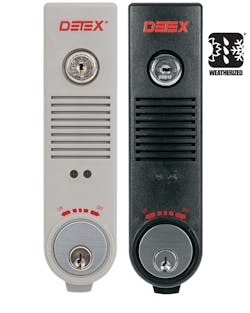Electronic access control (EAC) systems generally focus on controlling access through doors, managing cardholders, powering the door locks and tracking or logging system activities. They don’t provide quick, manageable alerts about propped doors or unauthorized exits though egress doors that can’t be locked.
Door alarms can fill this void, and that’s why they’ve been in use for the past 50 years, with improvements to reflect advances in technology.
Door alarms sound an audible and possibly visual signal from a controller located near an opening, typically on the door frame or a nearby wall. Some door alarms are free-standing self-powered devices, but they can be powered centrally and connected to a central control unit. More recently, door alarms have been integrated into other products, such as deadlock paddles, exit devices and maglocks, so they provide additional functions and represent a better investment for the end user.
The Old Days
On numerous projects, to fulfill a client’s request, I engineered door alarms by using outboard timers, sirens and switches. Because door alarms don’t affect the locking and unlocking of a door, there are few code consequences to doing this.
One of my early employers manufactured early versions of current door alarms. One of our products mounted on the door and had an integral door sensor, a horn, a visual indicator and a key switch. The alarm could be turned off for those times the door could be used without annunciation. Another model had an additional entry-delay feature, so if the door opened and reclosed within the allotted time, no alarm would sound.
Our third product had control boxes that had terminals for a door sensor, internal horn, light and key switch. The device was hard-wired back to a central multizone panel. We had a five-zone cabinet and a 10-zone cabinet. This provided identification of door status by zone and the ability to disarm and arm each zone. These panels were used in embassies, prisons, mental institutions and large retail stores.
Today’s Market
Security alarm systems typically don’t provide zoned alarm voltage outputs for visual or audible annunciation. In fact, most alarm systems are limited in function, with few options for customization.
The average alarm system is composed of two door contacts, a motion sensor and a keypad or control. Oh yes, and don’t forget the central-station monitoring contract.
An important new technology differentiator is that video surveillance and real-time offsite monitoring are available options for alarm and EAC systems.
Self-powered door alarms are relatively simple to install, often require no external wiring and don’t affect egress through the opening. Locking a door to prevent egress is illegal in most cases, and the next-closest alternative — delayed egress — is considered to be a special locking arrangement that’s costly and requires approval from the authority having jurisdiction prior to installation.
Door alarms can alert occupants when a door is ajar, open too long, propped or unlatched. This helps to deter piggybacking, which is when unauthorized individuals follow a credentialed individual through the door, and passback, when building occupants enter through an emergency exit door.
Detex Weighs In
Locksmith Ledger interviewed Detex sales engineer Joy Skowron and product manager Juan Hernandez about exit alarms. Here’s what they had to say.
Detex: Detex has battery-powered exit alarms (EAX-500, EAX-500W weatherized), hard-wired exit alarms (EAX-2500, EAX-2545) and a timed bypass alarm (EAX-3500).
We also have battery-powered door prop alarms (EAX-300, EAX-300W weatherized), hard-wired door prop alarms (EAX-411SK) and a door management alarm (EAX-4200).
LL: How have they evolved over the years?
Detex: They started with metal covers and back boxes. Most of the activation was accomplished by using mechanical components. This changed to the current material — ABS plastic — designed for use on all types of requirements as well as weather conditions. Current alarms have features that can be activated locally, a big change.
LL: Where are they used?
Detex: Some of the common uses are in hospitals, schools, retail stores, assisted-living facilities, warehouses, nurseries, museums, athletic facilities and back doors.
Weatherized prop alarms are becoming popular on gates for pools and secured areas. These are just a few examples, but the applications are endless.
One creative use is that some traveling groups or teams use hook-and-loop strips to temporarily affix a unit to hotel room doors to combat curfew infractions.
LL: What are some advantages of exit alarms?
Detex: Exit alarms in general are great for making sure that unattended doors aren’t used or exited through.
Timed-bypass alarms are great for back-door use. When trash has to be taken out or a delivery must be made, the alarm can be bypassed for a set amount of time, and the alarm will go off if the door isn’t closed within that set amount of time.
Hard-wired exit alarms have many advantages, because they can tie into new or existing door-monitoring or security systems. This allows remote monitoring of door status and localized monitoring via the sounder, which provides maximum coverage.
Advantages to battery-operated models are that they are loud and, by virtue of their size and battery operation, affordable.
LL: Are there fire-rated and nonfire-rated exit alarms?
Detex: The EAX-300 and EAX-500 are UL classified as “Fire Door Accessories.” They aren’t “fire rated.” This is because they’re an add-on alarm and not a function of keeping doors locked, closed or opened.
LL: Which of your products protect against unauthorized door activities?
Detex: Advantex and Value Series exit devices have alarms installed in the panic bar and come in hard-wired, weatherized and battery-operated models.
Got to www.detex.com for more information about Detex door alarms.
Certain facilities require special systems, and the locksmith should be familiar with the products, technologies and techniques available to meet those requirements. Below are some of the options on the market.
Alarm Lock alarms
Alarm Lock offers the PG21, PG30 and PG30KPM multifunction door alarms. These surface-mount, narrow-stile microprocessor-controlled door alarms increase security at any single or double door. They include a 95-decibel alarm, entry delay, key-removal and auto-shutdown or reset options.
Sirenlock Models 250, 260, 700 and 710 are UL listed panic alarm deadbolt devices that restrict unauthorized use of exit doors by sounding an alarm. They also provide instant egress during emergencies. SirenLock Model 715 is a delayed-egress exit alarm.
More info: www.alarmlock.com
Securitron DPA Door Prop Alarm
Securitron’s door prop alarm is designed to detect and deter a door from being left propped open.
The DPA series consists of a multifunction microprocessor-controlled timer. This sophisticated door prop alarm has numerous functions and options that permit tailoring the product to the specific requirements of the end user.
More info: www.securitron.com
STI Exit Stopper
The Exit Stopper can serve as an inexpensive door alarm and help to stop theft by alerting clients to any unauthorized exits or entries through emergency exit doors.
This self-contained unit can be mounted on top of or next to almost any door. A wireless version also is available.
In exit alarm mode, the alarm can be set to sound for 30 seconds, 3 minutes or indefinitely (unless disarmed by using the key supplied or until the battery is drained). In annunciator mode, it announces door entry or exit with two beeps repeated five times.
More info: www.sti-usa.com
SDC EA Series
SDC EA Series door prop alarms are compatible with all EAC systems but also can function as a stand-alone solution. All SDC door prop alarms feature audible sirens, adjustable timed delay, two outputs, a bypass status indicator light and vandal-resistant aluminum construction. The EA Series is available to install in single-gang or double-gang enclosures, and the exit alarms have optional keylock and mortise cylinder reset or bypass switches.
More info: www.sdcsecurity.com
Tim O’Leary is an experienced security consultant and a regular contributor to Locksmith Ledger.







